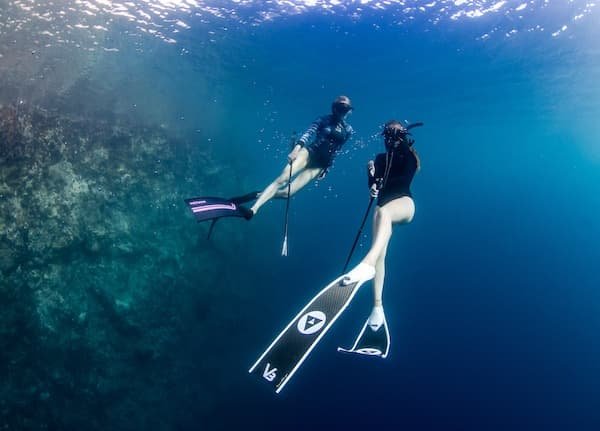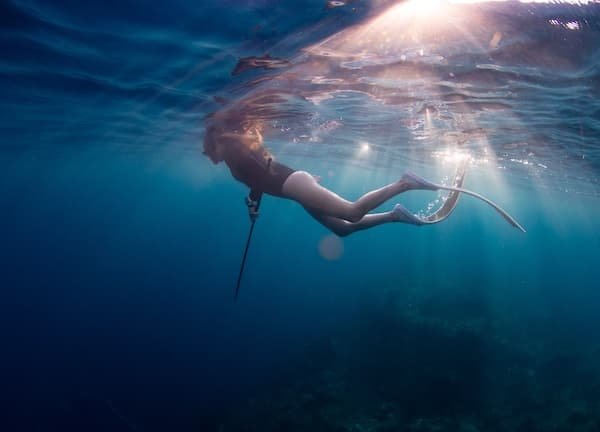In Soufriere, Dominica, the local economy is heavily dependent on fishing and offshore agriculture as many residents' main source of revenue. For hundreds of years, fishing has been done all over the island both on the Caribbean side and on the eastern side in the Atlantic Ocean. However, in Soufriere, Dominica, the bay is a protected marine reserve. So the only thing that we non-locals look for is the one fish that isn’t supposed to be there. The lionfish.

Lionfish have distinctive brown or maroon, and white stripes or bands covering the head and body. They have fleshy tentacles above their eyes and below their mouth. Totaling around 30-40 spines that wrap around their entire body. An adult lionfish can grow as large as 18 inches or 1.5 feet, while juveniles may be as small as 1 inch. Currently, they’re a flourishing invasive species in Dominica and all over Caribbean coastal waters. This invasive species is a top predator. Luckily for us, its beauty is its demise since its beautiful design makes them an easy target to spot.
Soufriere Bay has a reef that lines the outskirts of a volcanic crater. So the drop-off gets very steep, very fast. On the reef, we shoot around and within the rocks. That’s where they live. They have been hunted in this area for over 20 years since their initial spread.
Lionfish are one of the most docile fish you’ll ever hunt. Since they’re apex in the Atlantic and Caribbean, they aren’t disturbed when you come near them. This means you can get nice and close to them with your spear. You want to get a good shot with these guys. We use barbless prongs to make removing them from our spears contactless. So you have to get a good shot, otherwise, the fish can pull themselves loose. The tricky thing with lionfish is that you don’t want to get anywhere near them. So there’s no coming at them with a knife if you get a bad shot to brain them. They have spines on all ends and unless you’re wearing puncture-proof gloves, it’s not worth the risk.
Freedivers have to be strategic in the way that they plan their drops. The highest rate of decompression sickness occurs in spearfishers, in the freediving world. So you have to know and wait out your surface intervals.

Safety also changes when you’re spearfishing deep. This is important. The buddy system is ideal with a minimum of 3 divers, especially the water with sediment in it making the visibility worse. The first diver goes down and the two at the surface both have eyes on them, keeping them in sight and moving their positions if they [the first diver] drift. When divers 2 and 3 are about to lose sight of the first diver, the first safety will dive down and hover between 5-10 meters, keeping watch above the first diver. The third safety stays at the surface to safety’s the second diver. Depending on what you’re shooting and the power of the fish, the first diver might even want to hand off the fish to their first safety diver. This makes for an easier descent after the hunt.
For any spearfishing session, it’s important to discuss with your partners what type of spearfishing you intend on doing. We use the one-up, one-down, or two-up one-down, depending on how deep the drop is going to be. If it is a group of high-level freedivers, you can do some decent drops together with confidence that your partners are capable. My deepest dives are 35 meters and will often surpass 2:00 minutes.
There are three different ways to spearfish.
- Active spearfishing - dropping down, swimming dynamically, and searching for a target in the seabed.
- The ambush - getting to depth, holding still and depth, and waiting for a fish to pass by.
- Spearing from the surface - wait at the surface and wait for a fish to pass by.
For lionfish, we active spearfish. The catch bucket is tethered by a rope and allows us to deposit the lionfish in our bin, without touching them.

I usually wear the same suit I train in to be honest. That’s probably not a good thing, there’s a chance of me damaging on it on a reef and rocks during the session. Spearing wetsuits are more durable and are made with this in mind. But I know all my weighting with my training wetsuit so I wear it with that in mind. I treat the session like I do on a freediving line. I do a proper breath up and keep the same things in mind to keep movement minimal and stay efficient to get the most out of each drop. I am glad I began freediving on the line before freediving on the reef. Most spearos have to unlearn some bad habits when they come freediving on a line.
I have to focus when I do 30+m drops on the reef. Since the scuba divers hunt in the 10-30 meter range on the same reef freedivers hunt on. We must go deep for the big lionfish that live further below. The ones that live deeper are much darker in color, and often much larger.
Poison can be neutralized with hot water, as hot as you can handle! So it’s good to bring a thermos in case someone gets pricked. The reef is incredible to experience when you're in the state a freedive puts you in. It took me a while to get comfortable shooting lionfish. The venom consists of a neuromuscular toxin that’s similar to cobra venom in toxicity. It won’t kill you, but you might wish it did depending on the severity of the sting. The sting from a lionfish causes searing pain, numbness, temporary paralysis, and tissue necrosis.
But they don’t look so lethal. They’re beautiful fish, very peaceful. I don’t enjoy shooting and killing lionfish- or anything for that matter. So I always go for the headshot to brain them. For their sake and mind. Lionfish, they live within rocks. You have to aim with just enough power in order to spear the fish, without damaging the pole. If you miss, they retreat quickly to the rocks and begin to dwell deeper.

Sometimes we get lucky on hunts and find a lionfish “nest” with varying sizes. On my most recent hunt, we were able to pick off about 12 lionfish from just one rock. Between the 4 of us, we completely filled our catch bucket.
You want to skin them as soon as possible and get rid of those spikes. They aren’t the type of fish you can freeze or store whole. I fillet them with the spikes still on and keep the water boiled in case of a sting, even after they’ve died. As a beginner take the spines off. But I learned the hard way with the spikes on. It’s cleaner that way anyways. Skinning and filleting are easy with a good, flexible, and sharp knife. You can also keep the heads and make a broth.